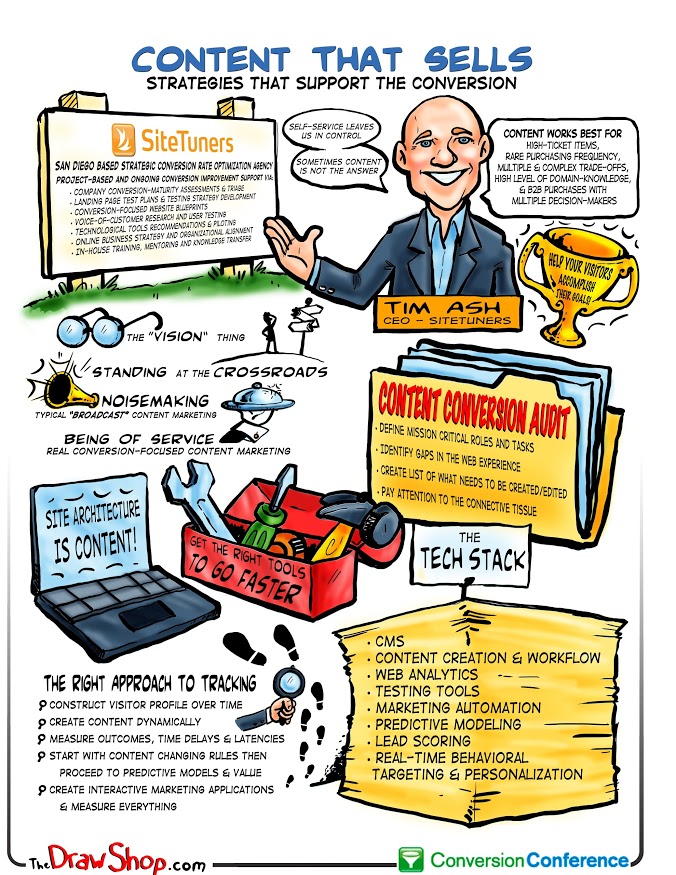At the 2015 Conversion Conference in Las Vegas, conference chair Tim Ash shared his tips for creating content that sells. Tim pointed out that 95 percent of marketers are doing content marketing wrong. In fact, majority of content efforts out there are geared toward “noisemaking” or broadcasting, which is characterized by the following:
- Pumping out content – infographics, webinars, whitepapers, blog posts, videos
- Focus is on editorial calendars, cadence, syndication and recycling
- Trying to engineer virality and popularity
- Using intermediate success metrics
- Hard time justifying ROI or payback on specific activities
So how do you finally get your content marketing on the right track?
According to Tim, the first question you have to ask yourself is, “is content the answer?” With all the noise out there, you want to make sure that you’re really providing value to your prospects and customers instead of just adding to the clutter. Tim says that content works best for the following:
- High-ticket items
- Rare purchasing frequency
- Multiple and complex trade-offs
- High level of domain-knowledge required for decision
- Business-to-business purchase with multiple decision-makers
Once you’ve determined that content is the most effective means to your marketing ends, you have to make sure that your pieces are created based on the needs of your visitors – and not that of your business. The easiest way to lose your visitors’ interest is to be too self-interested. Also, take care that your content is durable, laser-focused, and of excellent quality.
In addition, Tim shared the 3 strategies for content that sells:
3 Strategies for Content That Sells
1. Help visitors accomplish their goals
Creating content that stands out for their ability to be truly helpful for your visitors is easier said than done. Fortunately, Tim shared the steps for conducting the “Content for Conversion Audit,” which include:
- Defining mission critical roles and tasks (visitor scenarios and intent)
- Identifying gaps in the web experience, and supporting content
- Creating prioritized list of what needs to be created or edited
- Paying attention to the connective tissue (flow, CTAs, gating)
Want to learn more about writing content that converts?
Get the latest optimization tips and advice at Conversion Conference.
2. Get the right tools to go faster
There are now hundreds of tools to aid marketers in content creation. Marketers only need to choose the best ones depending on their needs and budget. But which tools should you definitely have in your technology stack? According to Tim, you should have a tool under each of the following categories to increase the effectiveness of your content marketing tactics:
- CMS
- Content creation & workflow
- Web analytics
- Testing tools
- Marketing automation
- Predictive modeling
- Lead scoring
- Real-time behavioral targeting & personalization
3. Track the right metrics and react quickly
A major reason for content marketing failure is the inability of many marketers to create and track the right metrics. As stated earlier, a lot of marketers are still stuck with vanity metrics when it comes to content, such as aiming for quantity or virality. As such, most of them often lack the crucial data for enlightened decision-making. According to Tim, the right approach to tracking consists of these steps:
- Construct visitor profile over time via progressive disclosure
- Create content dynamically to avoid losing information later
- Measure not only outcomes, but also time delays and latencies
- Start with basic content changing rules, then move to predictive models and value
- Create interactive marketing applications (typically with email gathering at the end) and measure everything
As more and more companies join the bandwagon and saturate the digital world with content, the competition to capture customers’ attention only grows fierce. To overcome the challenges of content marketing in a cluttered and noisy environment, marketers need to make smart decisions on content creation and deployment, effectively use the myriad of tools at their disposal, and internalize the value of measuring the right metrics of success for their content efforts.
Want to learn more about writing content that converts?
Get the latest optimization tips and advice at Conversion Conference.

 717 798 3495
717 798 3495



